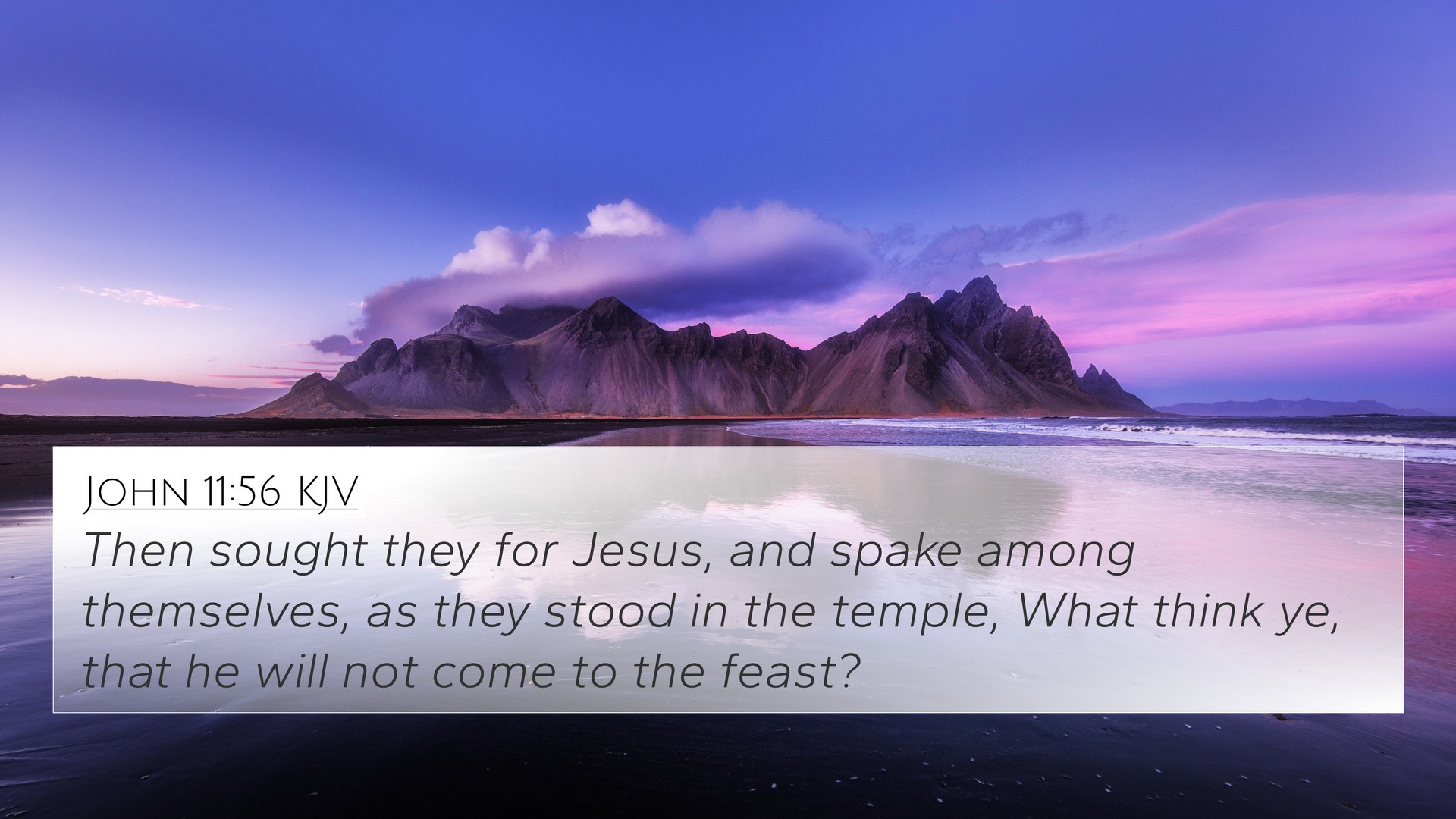John 11:56 Interpretation and Meaning
John 11:56 states: "Then they sought for Jesus, and spake among themselves, as they stood in the temple, What think ye, that he will not come to the feast?" This verse occurs in the context of the events leading up to the raising of Lazarus and Jesus's impending crucifixion. It highlights the confusion and speculation among the religious leaders and the public regarding Jesus's intentions.
Summary of Insights from Public Domain Commentaries
-
Matthew Henry's Commentary:
Matthew Henry comments on the curiosity of the people and the foreboding atmosphere regarding Jesus’s presence at the feast. He notes how the religious leaders were anxious about the possibility of Jesus attending the Passover, fearing that it would stir the crowds and lead to unrest. This verse reflects a transitional moment where Jesus's popularity and the hostility from religious authorities come to a head.
-
Albert Barnes's Notes:
Albert Barnes points out that the conversations among the people demonstrate their divided opinions about Jesus. Some anticipated His arrival, while others were cautious due to threats from the Pharisees. Barnes emphasizes how this verse illustrates the tenuous relationship between Jesus and the Jewish leaders, revealing the dangerous social dynamics at that time.
-
Adam Clarke's Commentary:
Clarke elaborates on the significance of the temple setting, suggesting that the discussion about Jesus amongst the visitors indicates their uncertainty about his intentions related to the upcoming feast. Clarke notes that this inquiry captures the essence of spiritual and political tensions, as the Jews wrestled with their expectations of Messiahship in light of Jesus’s teachings and actions.
Bible Verse Cross-References
This verse can be connected to several other passages in the Bible that illuminate its meaning and context. Here are key cross-references:
- Matthew 26:4 - Describes the plot against Jesus by the chief priests and scribes.
- John 7:1 - Indicates a similar tension where the Jews sought to kill Jesus.
- Luke 9:22 - Jesus predicts His own suffering and highlights the enmity of religious leaders.
- John 11:53 - After Lazarus's resurrection, the leaders plotted to put Jesus to death.
- Mark 14:1 - Further supports the context of plotting against Jesus during Passover.
- John 12:19 - Refers to the Pharisees' dismay over Jesus's increasing popularity.
- Matthew 21:46 - Illustrates the fear of the Pharisees concerning Jesus's influence among the people.
Thematic Connections
The themes surrounding John 11:56 resonate across Scripture, situating this moment in the broader narrative of Jesus's ministry and its culmination in sacrifice. The concerns over Jesus's potential actions during the feast highlight key themes such as:
- Anticipation and Fear: The dual emotions of hope and concern are palpable among the crowds and authorities.
- Messianic Identity: The inquiries about Jesus reflect a deep engagement with His claimed identity as the Messiah.
- Conflict with Authority: Emergent tensions between Jesus and the Jewish religious establishment are underscored in this verse.
- Faithfulness to God’s Plan: Jesus's journey and the reactions of others are part of a divine narrative unfolding towards redemption.
Application for Bible Study
For readers wanting to deepen their understanding through Bible cross-referencing, we recommend utilizing tools such as Bible concordances and cross-reference guides. These resources facilitate the exploration of connections between Bible verses and enhance Bible study methods. Here are helpful tips:
- Begin with a central verse, like John 11:56, and search for references related to its context.
- Consider thematic links, such as the concept of authority and its challenges in the Gospels.
- Engage in a comparative Bible verse analysis to uncover deeper layers of meaning.
- Utilize both Old and New Testament references to understand the continuity of God's message.
Conclusion
John 11:56 serves as a pivotal moment in the Gospel narrative, encapsulating the tension surrounding Jesus’s mission. By exploring Bible verse parallels and employing scriptural cross-referencing, readers can gain a richer understanding of the text, its implications in Jesus's ministry, and its relevance today.




